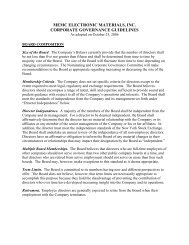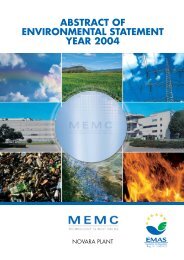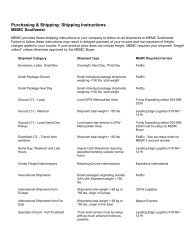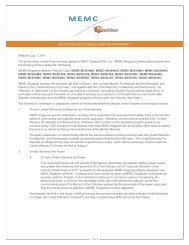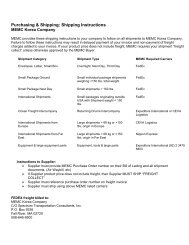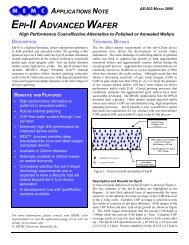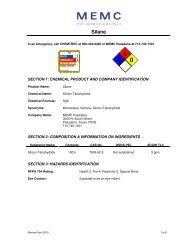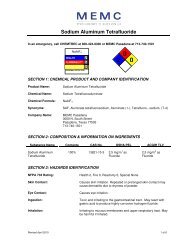BUILDING ON THE PAST, READY FOR THE FUTURE: - MEMC
BUILDING ON THE PAST, READY FOR THE FUTURE: - MEMC
BUILDING ON THE PAST, READY FOR THE FUTURE: - MEMC
You also want an ePaper? Increase the reach of your titles
YUMPU automatically turns print PDFs into web optimized ePapers that Google loves.
1959<br />
August 6, J. L.<br />
Christian, vice<br />
president of Monsanto<br />
Chemical Company,<br />
issues a press<br />
releasing announcing<br />
construction of a<br />
new plant for the<br />
manufacture of ultrapure<br />
silicon metal in<br />
St. Charles County,<br />
Missouri.<br />
1961<br />
Montecatini (Italian<br />
chemical company)<br />
undertakes the<br />
strategy to develop<br />
a pilot production of<br />
poly and single crystal<br />
at Merano. This Italian<br />
company would later<br />
become part of <strong>MEMC</strong>.<br />
1962<br />
Dr. Robert walsh of<br />
<strong>MEMC</strong> pioneers the<br />
chemical mechanical<br />
polishing process.<br />
1965<br />
Initially, Gordon Moore<br />
observes that transistor<br />
density is doubling every<br />
12 months. It is later<br />
modified to 24 months.<br />
The term ”Moore’s law“<br />
was coined around 1970<br />
by Caltech professor,<br />
VLSI pioneer, and<br />
entrepreneur Carver<br />
Mead.<br />
1966<br />
Scientists at <strong>MEMC</strong><br />
begin developing zerodislocation<br />
crystal.<br />
1968<br />
The first computer with<br />
16 integrated circuits is<br />
manufactured.<br />
The Czochralski (CZ)<br />
crystal-growing process is<br />
put into manufacturing at<br />
<strong>MEMC</strong>.<br />
Chemical mechanical<br />
polishing of silicon wafers<br />
is established at <strong>MEMC</strong>.<br />
joined the Monsanto Electronics Division<br />
in 1964, developed the process that helped<br />
make <strong>MEMC</strong> successful during his earlier<br />
years at Siemens.<br />
FloatIng Zone (FZ) Crystals<br />
The earliest crystals were grown using<br />
the Floating Zone (FZ) method and were<br />
used in the production of power rectifiers<br />
and transistors. Dr. Graham Fisher, current<br />
director of Intellectual Property for <strong>MEMC</strong>,<br />
described the process: “It started out with<br />
a polysilicon rod, and the process involved<br />
creating a molten zone with a moveable<br />
heater. The molten zone (floating zone or<br />
liquid zone) was thin and was held in place<br />
by surface tension. The floating zone could<br />
be moved slowly down the rod allowing<br />
single crystal silicon to grow behind it, thus<br />
converting polysilicon structure to single<br />
crystal. This could be repeated multiple<br />
times and the crystal would then be very<br />
pure, but it was very expensive to do. The<br />
crystals were quite small; the wafers were<br />
approximately half a millimeter thick, and<br />
you’d typically produce about twenty-five<br />
to thirty wafers to an inch.”<br />
By 1979, Monsanto St. Peters was supplying<br />
approximately 80 percent of the U.S. market<br />
for float-zoned silicon. The float zone<br />
process was phased out in the mid-1980s<br />
in favor of another process for producing<br />
crystal that had finally matured—the<br />
Czochralski (CZ) method.<br />
the CZoChralskI Method<br />
Growing crystals for wafers<br />
was job one at <strong>MEMC</strong>.<br />
However, the growing<br />
of crystals often meant<br />
more capacity, and<br />
Early CZ crystal.<br />
more space was needed,<br />
so the plants would



